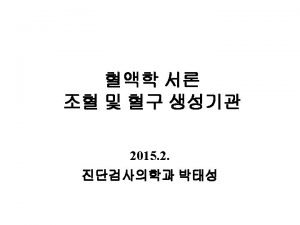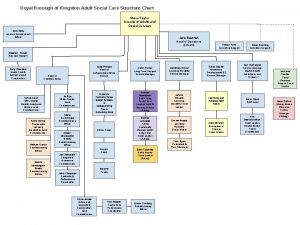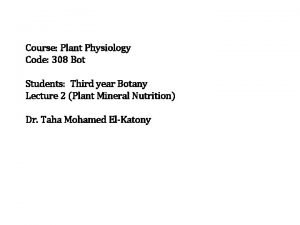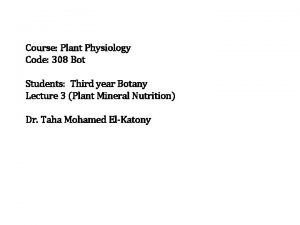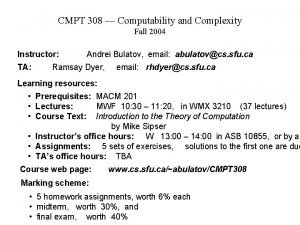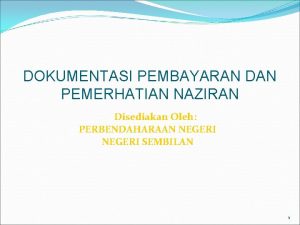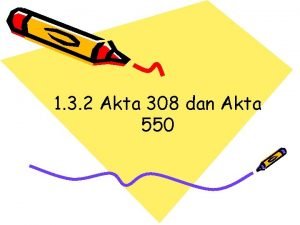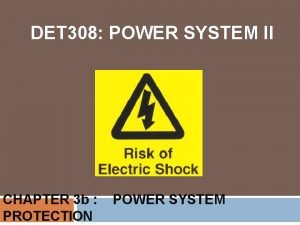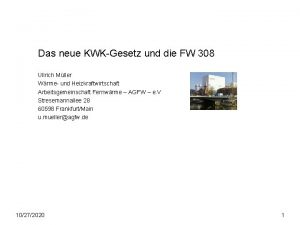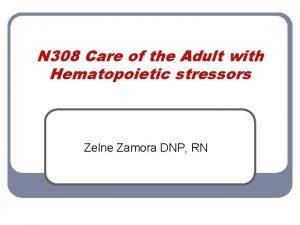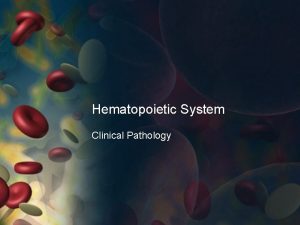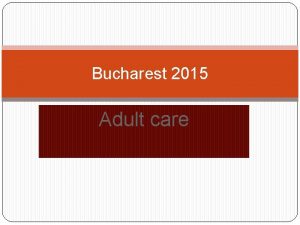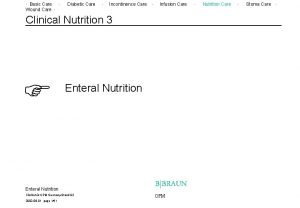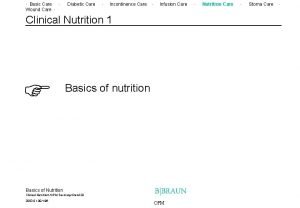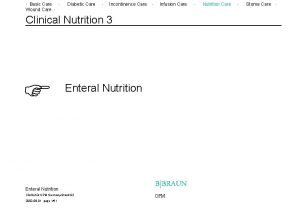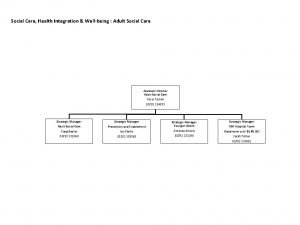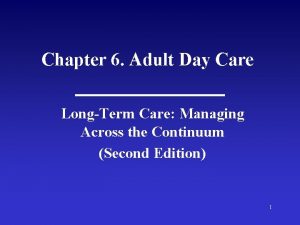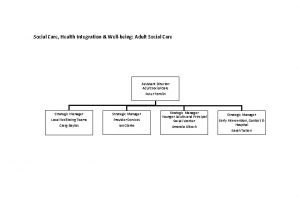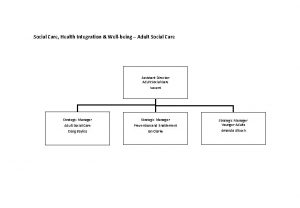N 308 Care of the Adult with Hematopoietic




















































- Slides: 52

N 308 Care of the Adult with Hematopoietic stressors

Blood Production Problems (Quantity Problems) l UNDERPRODUCTION l OVERPRODUCTION IMPAIRED PRODUCTION l • Hypoproliferative • Microcytic (RBCs small) • Macrocytic (RBCs large) • Hypochromic (↓Hemoglobin) • Hyperchromic (↑Hemoglobin)

Circulation - Patho

Circulation

Circulation - Purpose l l l Movement of nutrients and medications Oxygenation Homeostasis • • Fluid balance Acid-base balance

Blood Cells

Blood Cells

Plasma l l l Plasma proteins Clotting factors Other substances: nutrients, enzymes Waste products Gases

Albumin l l l Maintains fluid balance Binds substances to transfer in plasma, i. e. , meds Maintains osmotic forces

ANEMIA A client without sufficient red blood cells is said to be anemic.

Normal Red Blood Cell Count l l 4. 0 – 5. 4 million u/L Males are often slightly higher than females

Testing for CBC l l ü Non-fasting Can take blood sample from vein, artery or capillary Do not use vein where I. V. is located Do not massage area (heel stick, or fingers) • False low If tourniquet on too long, remove, wait, then try again üFalse high

Hemoglobin & Hematocrit l l Hemoglobin Normal Adult • l 12 -17 gm/dl l Hematocrit • 36 -51% of whole blood volume Is generally 3 X the hemoglobin value

Mean Corpuscular Hemoglobin l Amount of hemoglobin in an average red blood cell. l Normal MCH level is between 26 and 33 picograms (one trillionth of a gram) of hemoglobin per red blood cell.

MCV and RDW l l MCV – Mean Corpuscular Volume Average amount of space occupied by each red blood cell. The normal MCV level = between 78 and 98 cubic micrometers (abbreviated um 3) RDW – Red cell Distribution Width: Differences in sizes of the cells Normal RDW = variation of 11%-14. 5%

Common Cause: Hemorrhagic Blood Loss l l l Menstruation Childbirth Gastro-intestinal Trauma Abnormal cell morphology, i. e. , hemophilia

Common Cause: Poor Nutrition l l Inadequate intake of nutrients Inadequate absorption of nutrients (iron, folic acid, Vit. B 12)

Anemia

Iron Deficiency Anemia l Microcytic, hypochromic disorder

s/s Iron Deficiency l l Early: fatigue, weakness, pale skin Late: dyspnea, chest pain, muscle pain, cramping

Diagnostics l l l Hgb Hct Reticuloctye count indices MCV RDW

Too much iron in the body l l Hemochromatosis • • Genetic Iron absorbed from GI tract Common in Caucasian descent

Hemochromatosis l l Serial screening tests – alpha fetal proteins Serum iron studies Genetic counseling Tx: removal of blood

Iron Studies l l l Serum iron level TIBC % saturation Ferritin Differentiation of iron amounts in different areas of the body

Vitamin B 12 Deficiency l l l Pernicious anemia Macrocytic normochromic Lack of intrinsic factor Cheilosis, smooth sore tongue, neurological problems Schilling Test

Schilling Test l l l The Schilling test is performed to evaluate Vitamin B 12 absorption. Excretion of 8 to 40% of the radioactive Vitamin B 12 within 24 -hours is normal. The Schilling test is most commonly used to evaluate patients for pernicious anemia.

Folic Acid Deficiency l l l Macrocytic, normochromic Malnutrition Alcoholics Serum folate levels Birth defects

Folic Acid (B 9) l l Malabsorption Antibiotics: ampicillin, tetracycline Estrogen Symptoms similar to B 12

Drugs and Anemia l l AZT(Zidovudine) Phenytoin Methotrexate G 6 PD deficiency

Chronic Illness l l l Renal disease Rheumatoid arthritis Cancer

Kidney Dysfunction Patients l l l Likely to be anemic Under produce erythropoietin Uremia: bone marrow less likely to respond to the erythropoietin that is produced

Hemolysis l l l l l (erythrocyte destruction) Hereditary Spherocytosis Heavy metals (lead, copper) Malaria Prosthetic heart valves Vasculitis Malignant hypertension Sepsis Chemical poisoning Autoimmune diseases

Pregnant women have ↓ RBCs l l Dilutional Fluid retention dilutes RBCs

If RBCs are TOO HIGH you have polycythemia l l Sluggish flow ↑ clotting Tissue hypoxia High altitude

Polycythemia VERA l l l Overproduction of ALL blood cell types Blood removal is the treatment Bone marrow suppression drugs

Other causes of ↑ RBCs l l l Dehydration Smoking Drugs • • Gentamycin Methyldopa

Types of Anemia l Hemolytic l Nutritional • Thalassemia • Sickle cell • Spherocytosis • Iron deficiency • Folic Acid • Vitamin B 12

Types of Anemia l Production Impairment • Aplastic l Bone Marrow suppression • Cancer therapy

Thrombocytopenia l l l Not enough platelets Coagulation problems Bleeding

Thrombocytopenia l l Manual examination of peripheral smear Nursing: safety of patient: shaving, toothbrush, medications

Idiopathic Thrombocytopenic Purpura (ITP) l l Acute vs. chronic 1 -6 weeks post viral illness Self-limiting Dx: exclusion of other causes of thrombocytopenia

DIC is Triggered by? l l l l Sepsis Trauma Cancer Shock Toxins Allergic Reactions Emergency situation

NURSING CARE FOR DIC l l l Maintain optimal oxygenation Manage fluid replacement Monitor electrolyte imbalances Administer vasopressor meds as ordered Protect from falls/injury Provide emotional reassurance

Clotting tests l l Prothrombin time (PT) International Normalized Ratio (INR)

Clotting tests l Partial prothrombin time (PTT)

Bone Marrow Biopsies:

Blood Transfusions: Nursing Responsibilities l l Verify, Verify with 2 nurses! • Patient identification (name, record #, B. D. ) • Correct blood type, blood unit, exp. date • Set up I. V. access with saline • Answer patient questions Hang blood, use blood tubing with filter

Blood Transfusion Reactions: l l Febrile Non-hemolytic – most common Acute hemolytic – most dangerous Allergic reaction Circulatory overload

Blood Transfusion Reactions: l l Bacterial contamination TRALI – transfusion related acute lung injury – potentially fatal Delayed hemolytic reaction Disease acquisition

Blood Transfusions: Nursing Responsibilities l l Monitor Vital signs frequently Unit to hang < 4 hours, note patient condition to regulate flow.

TRANSFUSION REACTION! l l Stop the blood Have someone call M. D. Raise the head of the bed Apply 02

TRANSFUSION REACTION! l l l Hang new saline bag and tubing Monitor urine for amount/blood Frequent VS
 Hematopoietic drugs wikipedia
Hematopoietic drugs wikipedia Primary secondary tertiary health care
Primary secondary tertiary health care Stit sheffield
Stit sheffield Adult social care kingston
Adult social care kingston Giraffe vitals
Giraffe vitals Sec 308
Sec 308 Palsmodesmata
Palsmodesmata Bot 308
Bot 308 Present progressive escribir
Present progressive escribir 2cfr200.308
2cfr200.308 Cmpt 308
Cmpt 308 Udi dahan
Udi dahan Contoh buku daftar pemeriksaan mengejut ap 308
Contoh buku daftar pemeriksaan mengejut ap 308 Surat seksyen 308(1)
Surat seksyen 308(1) 308
308 Fw 308
Fw 308 Ona tili 19 mashq
Ona tili 19 mashq ưu thế lai là gì
ưu thế lai là gì Thẻ vin
Thẻ vin Tư thế ngồi viết
Tư thế ngồi viết Cái miệng bé xinh thế chỉ nói điều hay thôi
Cái miệng bé xinh thế chỉ nói điều hay thôi Các châu lục và đại dương trên thế giới
Các châu lục và đại dương trên thế giới Bổ thể
Bổ thể Từ ngữ thể hiện lòng nhân hậu
Từ ngữ thể hiện lòng nhân hậu Tư thế ngồi viết
Tư thế ngồi viết Giọng cùng tên là
Giọng cùng tên là Thơ thất ngôn tứ tuyệt đường luật
Thơ thất ngôn tứ tuyệt đường luật Chúa yêu trần thế alleluia
Chúa yêu trần thế alleluia Hổ sinh sản vào mùa nào
Hổ sinh sản vào mùa nào Diễn thế sinh thái là
Diễn thế sinh thái là đại từ thay thế
đại từ thay thế Vẽ hình chiếu vuông góc của vật thể sau
Vẽ hình chiếu vuông góc của vật thể sau Công thức tiính động năng
Công thức tiính động năng Làm thế nào để 102-1=99
Làm thế nào để 102-1=99 Tỉ lệ cơ thể trẻ em
Tỉ lệ cơ thể trẻ em Thế nào là mạng điện lắp đặt kiểu nổi
Thế nào là mạng điện lắp đặt kiểu nổi Lời thề hippocrates
Lời thề hippocrates Vẽ hình chiếu đứng bằng cạnh của vật thể
Vẽ hình chiếu đứng bằng cạnh của vật thể Quá trình desamine hóa có thể tạo ra
Quá trình desamine hóa có thể tạo ra Môn thể thao bắt đầu bằng từ chạy
Môn thể thao bắt đầu bằng từ chạy Sự nuôi và dạy con của hươu
Sự nuôi và dạy con của hươu Hát kết hợp bộ gõ cơ thể
Hát kết hợp bộ gõ cơ thể Dot
Dot Biện pháp chống mỏi cơ
Biện pháp chống mỏi cơ Trời xanh đây là của chúng ta thể thơ
Trời xanh đây là của chúng ta thể thơ Phản ứng thế ankan
Phản ứng thế ankan Voi kéo gỗ như thế nào
Voi kéo gỗ như thế nào Thiếu nhi thế giới liên hoan
Thiếu nhi thế giới liên hoan Fecboak
Fecboak điện thế nghỉ
điện thế nghỉ Một số thể thơ truyền thống
Một số thể thơ truyền thống Thế nào là hệ số cao nhất
Thế nào là hệ số cao nhất Slidetodoc
Slidetodoc
